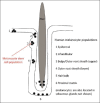Abnormal pigmentation within cutaneous scars: A complication of wound healing
- PMID: 23162241
- PMCID: PMC3495392
- DOI: 10.4103/0970-0358.101328
Abnormal pigmentation within cutaneous scars: A complication of wound healing
Abstract
Abnormally pigmented scars are an undesirable consequence of cutaneous wound healing and are a complication every single individual worldwide is at risk of. They present a challenge for clinicians, as there are currently no definitive treatment options available, and render scars much more noticeable making them highly distressing for patients. Despite extensive research into both wound healing and the pigment cell, there remains a scarcity of knowledge surrounding the repigmentation of cutaneous scars. Pigment production is complex and under the control of many extrinsic and intrinsic factors and patterns of scar repigmentation are unpredictable. This article gives an overview of human skin pigmentation, repigmentation following wounding and current treatment options.
Keywords: Melanin; melanogenesis; pigmentation; scar(s); wound.
Conflict of interest statement
Figures





Similar articles
-
Repigmentation of cutaneous scars depends on original wound type.J Anat. 2013 Jul;223(1):74-82. doi: 10.1111/joa.12052. Epub 2013 May 14. J Anat. 2013. PMID: 23668313 Free PMC article.
-
Successful Repigmentation of Full-Thickness Wound Healing in Fraser's Dolphins (Lagenodelphis hosei).Animals (Basel). 2022 Jun 8;12(12):1482. doi: 10.3390/ani12121482. Animals (Basel). 2022. PMID: 35739819 Free PMC article.
-
Cutaneous side effects from laser treatment of the skin: skin cancer, scars, wounds, pigmentary changes, and purpura--use of pulsed dye laser, copper vapor laser, and argon laser.Acta Derm Venereol Suppl (Stockh). 1999;207:1-32. Acta Derm Venereol Suppl (Stockh). 1999. PMID: 10605602
-
Techniques for Optimizing Surgical Scars, Part 1: Wound Healing and Depressed/Atrophic Scars.Skinmed. 2017 Aug 1;15(4):271-276. eCollection 2017. Skinmed. 2017. PMID: 28859737 Review.
-
Non-animal models of wound healing in cutaneous repair: In silico, in vitro, ex vivo, and in vivo models of wounds and scars in human skin.Wound Repair Regen. 2017 Apr;25(2):164-176. doi: 10.1111/wrr.12513. Epub 2017 Feb 20. Wound Repair Regen. 2017. PMID: 28120405 Review.
Cited by
-
Punch Incision with Secondary Healing (PISH) Technique for Benign Facial Lesions: An Institutional Experience in 307 Patients.Indian J Plast Surg. 2021 Apr;54(2):138-143. doi: 10.1055/s-0041-1731257. Epub 2021 Jun 22. Indian J Plast Surg. 2021. PMID: 34239234 Free PMC article.
-
Nanofat Injection for the Treatment of Depressed Facial Scars.Aesthetic Plast Surg. 2021 Aug;45(4):1762-1771. doi: 10.1007/s00266-021-02178-7. Epub 2021 Feb 26. Aesthetic Plast Surg. 2021. PMID: 33635346
-
Morphological characteristics of facial scars: A retrospective analysis according to scar location, onset, age, and cause.Int Wound J. 2024 Apr;21(4):e14453. doi: 10.1111/iwj.14453. Epub 2023 Dec 6. Int Wound J. 2024. PMID: 38058010 Free PMC article.
-
Clinical trial to evaluate the efficacy of botulinum toxin type A injection for reducing scars in patients with forehead laceration: A double-blinded, randomized controlled study.Medicine (Baltimore). 2019 Aug;98(34):e16952. doi: 10.1097/MD.0000000000016952. Medicine (Baltimore). 2019. PMID: 31441893 Free PMC article. Clinical Trial.
-
Race Does Not Predict Melanocyte Heterogeneous Responses to Dermal Fibroblast-Derived Mediators.PLoS One. 2015 Sep 29;10(9):e0139135. doi: 10.1371/journal.pone.0139135. eCollection 2015. PLoS One. 2015. PMID: 26418010 Free PMC article.
References
-
- Morgan JE, Gilchrest B, Goldwyn RM. Skin pigmentation. Current concepts and relevance to plastic surgery. Plast Reconstr Surg. 1975;56:617–28. - PubMed
-
- Tyack ZF, Pegg S, Ziviani J. Postburn dyspigmentation: its assessment, management, and relationship to scarring--a review of the literature. J Burn Care Rehabil. 1997;18:435–40. - PubMed
-
- Wisely JA, Hoyle E, Tarrier N, Edwards J. Where to start? Attempting to meet the psychological needs of burned patients. Burns. 2007;33:736–46. - PubMed
-
- Zeitlin RE. Long-term psychosocial sequelae of paediatric burns. Burns. 1997;23:467–72. - PubMed
-
- Jablonski NG. The Evolution of Human Skin and Skin Color. Annu Rev Anthropol. 2004;33:585–623.
LinkOut - more resources
Full Text Sources
Medical

